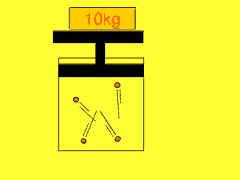The high velocity molecules of a gas placed in a confined space can generate tremendous forces. Forces that can be harnessed to do useful work by driving heavy machinery. The energy to drive water molecules to such speeds came from wood. The energy in the wood (chemical potential energy) was released as heat. Heat is absorbed by the water molecules which soon convert this energy into motion energy (kinetic energy) and accelerate into space colliding violently with each other and more importantly with the walls of the container.

Gas pressure can be generated and put to great use. The Industrial Revolution relied heavily on gas pressure, namely steam, to drive the heavy machinery.
